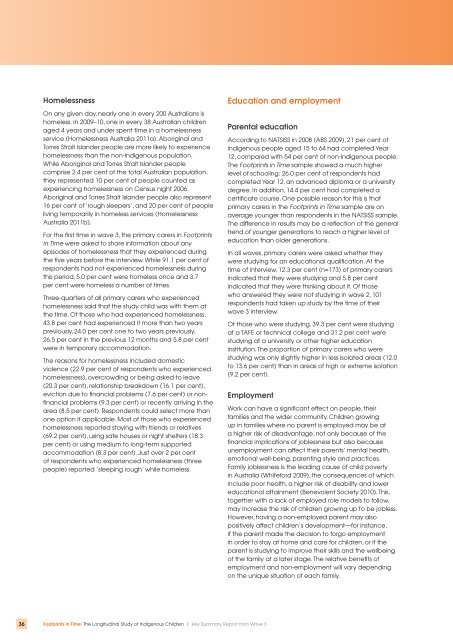Summary Report - pdf - Department of Families, Housing ...
Summary Report - pdf - Department of Families, Housing ...
Summary Report - pdf - Department of Families, Housing ...
You also want an ePaper? Increase the reach of your titles
YUMPU automatically turns print PDFs into web optimized ePapers that Google loves.
HomelessnessOn any given day, nearly one in every 200 Australians ishomeless. In 2009–10, one in every 38 Australian childrenaged 4 years and under spent time in a homelessnessservice (Homelessness Australia 2011a). Aboriginal andTorres Strait Islander people are more likely to experiencehomelessness than the non-Indigenous population.While Aboriginal and Torres Strait Islander peoplecomprise 2.4 per cent <strong>of</strong> the total Australian population,they represented 10 per cent <strong>of</strong> people counted asexperiencing homelessness on Census night 2006.Aboriginal and Torres Strait Islander people also represent16 per cent <strong>of</strong> ‘rough sleepers’, and 20 per cent <strong>of</strong> peopleliving temporarily in homeless services (HomelessnessAustralia 2011b).For the first time in wave 3, the primary carers in Footprintsin Time were asked to share information about anyepisodes <strong>of</strong> homelessness that they experienced duringthe five years before the interview. While 91.1 per cent <strong>of</strong>respondents had not experienced homelessness duringthis period, 5.0 per cent were homeless once and 3.7per cent were homeless a number <strong>of</strong> times.Three-quarters <strong>of</strong> all primary carers who experiencedhomelessness said that the study child was with them atthe time. Of those who had experienced homelessness,43.8 per cent had experienced it more than two yearspreviously, 24.0 per cent one to two years previously,26.5 per cent in the previous 12 months and 5.8 per centwere in temporary accommodation.The reasons for homelessness included domesticviolence (22.9 per cent <strong>of</strong> respondents who experiencedhomelessness), overcrowding or being asked to leave(20.3 per cent), relationship breakdown (16.1 per cent),eviction due to financial problems (7.6 per cent) or nonfinancialproblems (9.3 per cent) or recently arriving in thearea (8.5 per cent). Respondents could select more thanone option if applicable. Most <strong>of</strong> those who experiencedhomelessness reported staying with friends or relatives(69.2 per cent), using safe houses or night shelters (18.3per cent) or using medium to long-term supportedaccommodation (8.3 per cent). Just over 2 per cent<strong>of</strong> respondents who experienced homelessness (threepeople) reported ’sleeping rough’ while homeless.Education and employmentParental educationAccording to NATSISS in 2008 (ABS 2009), 21 per cent <strong>of</strong>Indigenous people aged 15 to 64 had completed Year12, compared with 54 per cent <strong>of</strong> non-Indigenous people.The Footprints in Time sample showed a much higherlevel <strong>of</strong> schooling: 26.0 per cent <strong>of</strong> respondents hadcompleted Year 12, an advanced diploma or a universitydegree. In addition, 14.4 per cent had completed acertificate course. One possible reason for this is thatprimary carers in the Footprints in Time sample are onaverage younger than respondents in the NATSISS sample.The difference in results may be a reflection <strong>of</strong> the generaltrend <strong>of</strong> younger generations to reach a higher level <strong>of</strong>education than older generations.In all waves, primary carers were asked whether theywere studying for an educational qualification. At thetime <strong>of</strong> interview, 12.3 per cent (n=173) <strong>of</strong> primary carersindicated that they were studying and 5.8 per centindicated that they were thinking about it. Of thosewho answered they were not studying in wave 2, 101respondents had taken up study by the time <strong>of</strong> theirwave 3 interview.Of those who were studying, 39.3 per cent were studyingat a TAFE or technical college and 31.2 per cent werestudying at a university or other higher educationinstitution. The proportion <strong>of</strong> primary carers who werestudying was only slightly higher in less isolated areas (12.0to 13.6 per cent) than in areas <strong>of</strong> high or extreme isolation(9.2 per cent).EmploymentWork can have a significant effect on people, theirfamilies and the wider community. Children growingup in families where no parent is employed may be ata higher risk <strong>of</strong> disadvantage, not only because <strong>of</strong> thefinancial implications <strong>of</strong> joblessness but also becauseunemployment can affect their parents’ mental health,emotional well-being, parenting style and practices.Family joblessness is the leading cause <strong>of</strong> child povertyin Australia (Whiteford 2009), the consequences <strong>of</strong> whichinclude poor health, a higher risk <strong>of</strong> disability and lowereducational attainment (Benevolent Society 2010). This,together with a lack <strong>of</strong> employed role models to follow,may increase the risk <strong>of</strong> children growing up to be jobless.However, having a non-employed parent may alsopositively affect children’s development—for instance,if the parent made the decision to forgo employmentin order to stay at home and care for children, or if theparent is studying to improve their skills and the wellbeing<strong>of</strong> the family at a later stage. The relative benefits <strong>of</strong>employment and non-employment will vary dependingon the unique situation <strong>of</strong> each family.36 Footprints in Time: The Longitudinal Study <strong>of</strong> Indigenous Children | Key <strong>Summary</strong> <strong>Report</strong> from Wave 3




![pdf [107kB] - Department of Families, Housing, Community Services](https://img.yumpu.com/51272499/1/190x245/pdf-107kb-department-of-families-housing-community-services.jpg?quality=85)










![Land Claim - pdf [278kB] - Department of Families, Housing ...](https://img.yumpu.com/47002639/1/184x260/land-claim-pdf-278kb-department-of-families-housing-.jpg?quality=85)

![Borroloola Land Claim - pdf [299kB] - Department of Families ...](https://img.yumpu.com/46103973/1/184x260/borroloola-land-claim-pdf-299kb-department-of-families-.jpg?quality=85)